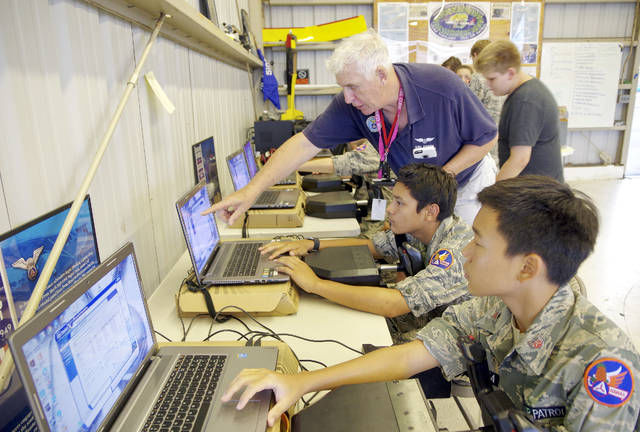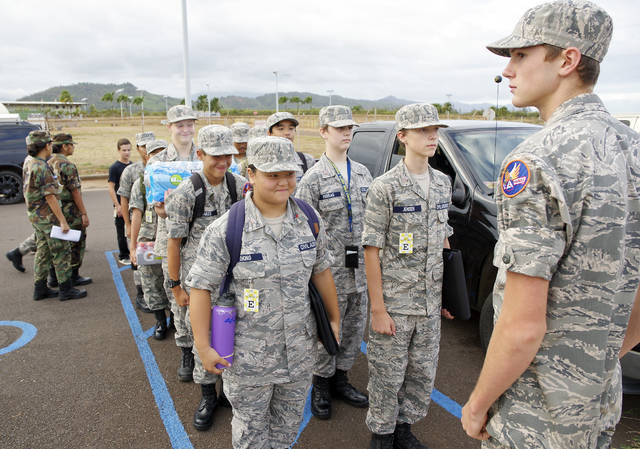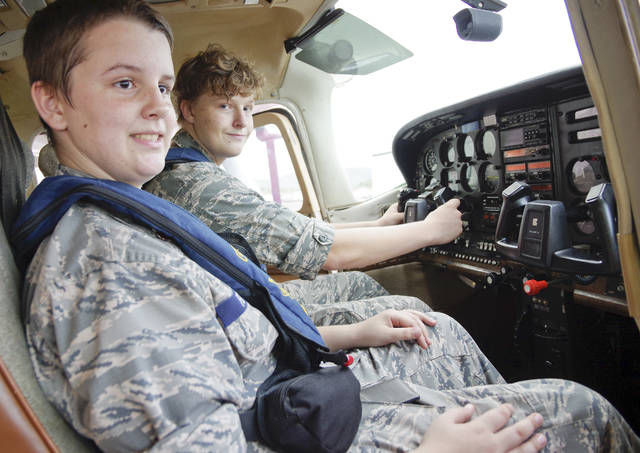LIHUE — Flying, or learning to fly, is something Civil Air Patrol Cadet Stephan Jensen always wanted to do. “My goal is to one day become a pilot,” said Jensen, one of 38 CAP cadets at a meeting of the
LIHUE — Flying, or learning to fly, is something Civil Air
Patrol Cadet Stephan Jensen always wanted to do.
“My goal is to one day become a pilot,” said Jensen, one of 38 CAP cadets at a meeting of the Kauai Composite Squadron, Hawaii Wing, CAP at the Lihue T hangars on Tuesday.
Jensen was one of the cadets who took part in the Cadet Orientation Flight Program which introduces youth to general aviation through hands-on orientation flights in single engine aircraft and gliders. The program’s goal is to teach aerospace education, including science, engineering, technology, and develop leadership skills.
“It was a lot more scary than it was hard,” Jensen said. “The feeling is kind of like when you learn to drive and are behind the wheel for the first time — you have a lot of doubts about yourself.”
Under the Cadet Orientation Flight Program, each cadet member is eligible for 10 orientation rides which are fully funded by the U.S. Air Force under whose auspices the Civil Air Patrol operates as an auxiliary, said Maj. Susan Caires, spokeswoman for the Kauai Composite Squadron.
“Five of these flights are in powered aircraft, and the other five are in gliders,” Caires said. “However, a cadet may ride back seat as many times as they wish to observe aircraft operations. Each of the flights will focus on a specific aspect of aviation, amd there is a learning syllabus for each flight. Before, during, and after the flight, cadets will have a hands-on approach to learning about how airplanes work.”
Cadet Isaiah Ferran said he’s been a cadet since July and took part in one of the orientation flights. He, like many others, was still in the air.
“It was fun,” said Ferran, agreeing with several other cadets who experienced flying. “It was about an hour long and we did some 360-degree turns and swerving turns. If we wanted to, we could do some 180-degree turns, or a steep bank. We get to look at the gauges and have to follow the instructors’ directions before we leave.”
With a program motto of safe, fun, educational, the orientation flight day is one of the highlights of the CAP Cadet experience, Caires said. Many cadets have earned their Solo Wings, and pursued aviation careers after flying in the CAP Orientation Flight Program.
“The orientation flight is just one of several areas we have broken down the field into,” said Capt. Ken Kriner, in charge of the cadets. “The cadets start with training on simulators, learn about maps, map reading, and get involved in other areas including building robots, and other things. One thing doesn’t ring everybody’s bell so we have all kinds of things cadets can get excited about.”
First Lt. Tim Ferran said the goal of the Kauai Composite Squadron is to build to 50 cadets.
“This helps build the CAP which is a U.S. Air Force Auxiliary,” he said. “As such, we’re involved with the county and state in a lot of the life- and property-threatening events, including serving as the tsunami warning arm. During the last big fire, we were in the air doing photos which are turned over to the county. We are also getting ready to do a big state exercise in October, here on Kauai.”
Ferran said the Kauai Composite Squadron hosts three of the state’s 11 CAP powered aircraft, and more than 100 members.
When you reach 18 years old, you are eligible to become a Senior Cadet which offers more opportunities for advancement, Ferran said. He said Cadet eligibility lasts until you turn 21 years old.
Jensen said it’s a lot of paperwork.
“Tonight, I need to finish my resume for my job,” he said. “It’s an entry-level job, but I’m on my way to becoming a pilot.”




